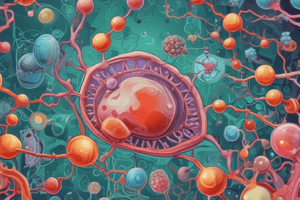Podcast
Questions and Answers
What is the widely accepted model of plasma membrane structure?
What is the widely accepted model of plasma membrane structure?
- Solid mosaic model
- Fluid mosaic model (correct)
- Stable phospholipid model
- Rigid bilayer model
What is the main function of the cell membrane?
What is the main function of the cell membrane?
- To allow only certain substances to pass through (correct)
- To store genetic information
- To provide energy for the cell
- To maintain the rigid structure of the cell
What is the role of cholesterol in the plasma membrane?
What is the role of cholesterol in the plasma membrane?
- To transport substances in and out of the cell
- To facilitate energy production
- To provide structural support to the membrane (correct)
- To store genetic information
Which components form a bilayer in the plasma membrane?
Which components form a bilayer in the plasma membrane?
According to the fluid mosaic model, what forms a shifting pattern within the fluid phospholipid bilayer?
According to the fluid mosaic model, what forms a shifting pattern within the fluid phospholipid bilayer?
What type of membrane is the cell membrane?
What type of membrane is the cell membrane?
What does the fluid mosaic model state about the consistency of the cell membrane?
What does the fluid mosaic model state about the consistency of the cell membrane?
Which type of transport involves the movement of substances across the cell membrane against their concentration gradient?
Which type of transport involves the movement of substances across the cell membrane against their concentration gradient?
What does the term 'selectively permeable' mean in relation to the cell membrane?
What does the term 'selectively permeable' mean in relation to the cell membrane?
What is the function of vesicle transport in cells?
What is the function of vesicle transport in cells?
Which model provides a working description of membrane structure by indicating that protein molecules form a shifting pattern within the fluid phospholipid bilayer?
Which model provides a working description of membrane structure by indicating that protein molecules form a shifting pattern within the fluid phospholipid bilayer?
What does osmosis refer to in relation to cell membranes?
What does osmosis refer to in relation to cell membranes?
Which of the following is NOT a function of the cell membrane?
Which of the following is NOT a function of the cell membrane?
In which type of junction are proteins that hold adjacent cells together very tightly so nothing can penetrate between them?
In which type of junction are proteins that hold adjacent cells together very tightly so nothing can penetrate between them?
Which process describes the movement of substances across the membrane without the input of cellular energy?
Which process describes the movement of substances across the membrane without the input of cellular energy?
Which process involves vesicles fusing with the plasma membrane and releasing their contents to the outside of the cell?
Which process involves vesicles fusing with the plasma membrane and releasing their contents to the outside of the cell?
What are fingers like extensions of plasma membrane involved in absorption, particularly abundant on the surface of epithelial cells lining the intestine called?
What are fingers like extensions of plasma membrane involved in absorption, particularly abundant on the surface of epithelial cells lining the intestine called?
What are carbohydrates attached to proteins forming glycoproteins or to lipids forming glycolipids, present only on the outer surface of the plasma membrane?
What are carbohydrates attached to proteins forming glycoproteins or to lipids forming glycolipids, present only on the outer surface of the plasma membrane?
What type of proteins serve as receptors that bind specific molecules such as hormones?
What type of proteins serve as receptors that bind specific molecules such as hormones?
Flashcards are hidden until you start studying
Study Notes
- College of Medicine Lecture by Zahraa Ch. Hameed on Medical Biology, topic: 3 Cell structures and function, specifically the Cell Membrane
- Learning Objectives: define, describe structure, functions, and specializations of the Cell Membrane; understand processes of diffusion, osmosis, facilitated diffusion, active transport, and vesicle transport
- Cell Membrane: thin, semi-permeable membrane surrounding cytoplasm; fluid mosaic model structure comprises phospholipids, cholesterol, proteins, and carbohydrates
- Phospholipids: form bilayer with polar heads outward and nonpolar tails inward
- Cholesterol: improves stability and reduces fluidity in animal cell membranes
- Proteins: integral (transmembrane) or peripheral; serve various roles such as channel, carrier, cell recognition, receptor, and enzymatic functions
- Carbohydrates: attached to proteins or lipids, forming glycoproteins or glycolipids, present only on outer surface
- Function of Cell Membrane: protects, identifies, regulates substance passage, communicates, and anchors cytoskeleton
- Cell Membrane Specialization: microvilli (fingers-like extensions), intercellular junctions (tight, gap, desmosomes)
- Movement across Cell Membranes: passive (simple diffusion, facilitated diffusion, osmosis) and active (active transport, vesicle transport) processes
- Passive ways: diffusion (net movement of particles from higher to lower concentration), facilitated diffusion (assisted by carrier protein), osmosis (diffusion of water)
- Active ways: active transport (energy-demanding transfer from lower to higher concentration), vesicle transport (movement of macromolecules through vesicles)
- Endocytosis: vesicles engulfing particles from outside; pinocytosis (small particles) and phagocytosis (solid particles)
- Exocytosis: vesicles releasing contents to outside; occurs when cell produces substances for export or eliminates waste/toxins.
Studying That Suits You
Use AI to generate personalized quizzes and flashcards to suit your learning preferences.




